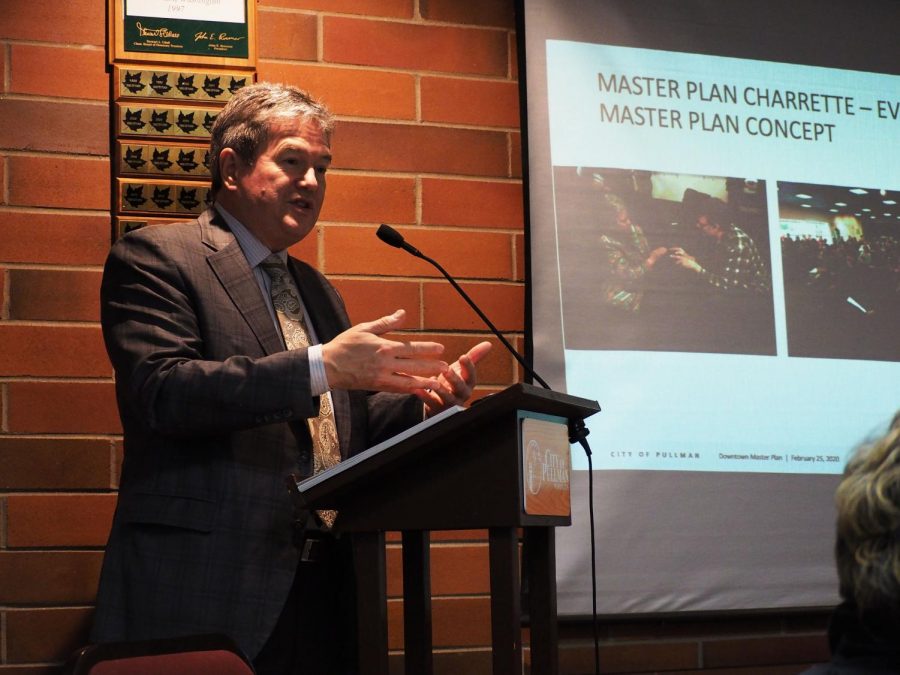
GRACE JOO | DAILY EVERGREEN FILE
Brian Scott, Principal of BDS Planning and Urban Design, says suggested changes in the plan could take $5 million and, spread out over several years, that is manageable. He says it will take a lot more money if city officials decide to build a bypass over Paradise Creek.
Pullman may
see an influx of new businesses and changes to the structure of the downtown
district if city officials adopt a Master Plan created by BDS Planning and
Urban Design.
Brian Scott, principle of BDS, presented the
Master Plan at Tuesday’s city council meeting and Wednesday’s Pullman Planning
Commission meeting.
He said the
first major part of the master plan would be to change the amount of lanes on
East Main Street from three lanes to two.
“We’ve spent a
lot of time discussing that and you don’t have the traffic counts to justify
three lanes there,” he said. “We think you can reduce the number of lanes which
would allow you to make it more people-centric.”
Scott said the
changes would include angled parking on the side of the street and a 10-foot
bike lane.
He said
Pullman has more parking than is necessary and it is not well managed or easily
visible.
“Prioritize
the on-street parking for customer and visitor uses,” he said. “The business
owners, employees and residents should be parking in parking lots that are off
of the streets.”
He said there
are also not enough handicap spaces downtown, which is an area of concern.
Scott said
installing prominent art pieces can bring a sense of excitement and livelihood
to the downtown area.
Scott said
they have been putting together this plan over the past eight months and have
been revising it ever since.
“The
consultant team spent two whole days developing a plan,” he said. “One hundred
plus people have contributed to this process.”
Scott said
there are many things that can be implemented within the city of Pullman which
could add to its already prominent heritage and identity.
“There is an
abundance of places worth celebrating,” he said. “Making downtown special and
unique should be widely promoted.”
Brent Carper,
Pullman Planning Commission member, said it would be easy for the Pullman
community to install public art with the help of WSU’s fine arts department.
“I like the
idea of meeting at a location that is a place of art rather than saying, ‘Yeah
I’ll meet you at that business building,’” Carper said.
Scott said
another part of the plan is to relocate the bus transfer station to the
downtown area.
“This way, the
people can interact with downtown instead of being stuck up on that hill where
the bus stop is now,” he said.
Pullman
Planning Commission Member, Scott Hodge, asked what kind of new businesses
would be proposed in the master plan.
Scott said
this would include new retail stores, restaurants, bars and a boutique hotel.
“There could
be room for even more development on the north side of the river and up the
hill towards the Gladish center,” he said.
Some members
of the commission voiced their questions and concerns with Scott after all the
information was presented.
Stephanie
Rink, Pullman Planning Commission member, said there is not a lot of safety on
the sidewalks, which is a concern for children who walk to school.
She asked
Scott if he talked to the public safety department about how the plan will
implement safety considering the traffic on Main Street and Grand Avenue.
“All
throughout this plan we are talking about improving the pedestrian crossing
experience,” he said. “We do this with pedestrian favored signals and ‘curb
bulb-outs’ on sidewalks to shorten the amount of distance to cross the street.”
Curb bulb-outs
are used to extend sidewalks to decrease the length of street pedestrians have
to cross. This would increase pedestrian safety, he said.
Rink asked
Scott if he has put together a budget for this proposal.
“It’s not
free, but it also isn’t a ton of money, and I would start there,” Scott said.
“At some point you might want to think about a bypass that would cross the
river and that would cost a ton.”
Scott said the
first couple of years of development could cost a few hundred thousand dollars.
“If the big improvements
are gonna cost five million, that’s gonna seem really crazy in the short run,”
he said. “But if you get a lot of things going over five years and there is
more activity happening then suddenly, $5 million seems like a reasonable
thing.”
